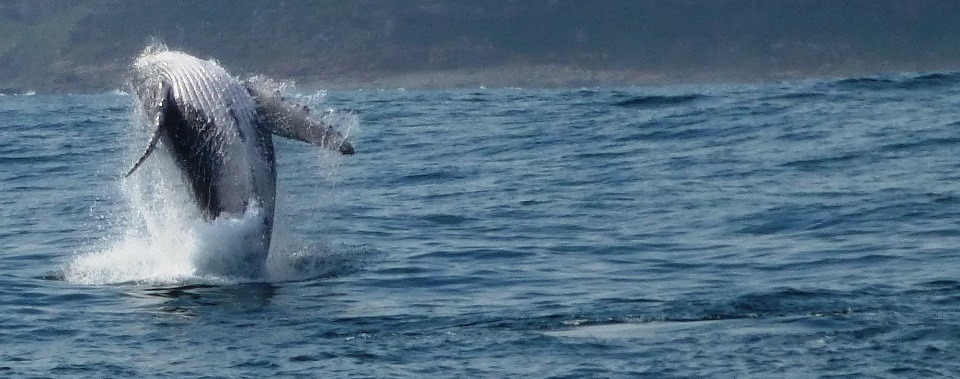Humpback whales (Megaptera novaeangliae) around Southern Africa and the Arabian Sea.

Humpback whales can be found in all the world oceans. They are classified as one single species, but there are sub populations that should be classified as subspecies. Humpback whales from the northern and southern hemisphere should be recognized as separate species because they do not cross the equator. Around Africa there are six breeding populations: two occur on the west coast and are grouped as (1) Gabon, Cabinda and (2) West South Africa; four on the east coast are grouped as (1) Mozambique, East South Africa, (2) Mayotte, Geyser, Comoros, (3) Madagascar and (4) Arabian Sea, Oman.
Since 2008 the Arabian Sea humpback whale population has been classified as endangered by the International Union for the Conservation of Nature (IUCN). This population is unique because of its year round residency in the sub-tropical waters of the Arabian Sea. One reason that this population is able to stay in one area all year round is the high food production created by the southwest monsoon system. This is one of the five largest upwelling systems in the world. According to the old whaling records, dead female humpback whales caught in this region were both lactating and feeding at the same time, proving that they live and breed in their feeding area. The total population size is unknown, but estimations from the coast of Oman are 82 individuals making it the world’s most endangered whale population. The Arabian Sea population has the same physical appearance as other humpback whales, but their fluke patterns are significantly different from other populations around the world.
The Arabian Sea humpback whales occur in the northern hemisphere and therefore exhibit similar breeding cycles to the other northern hemisphere populations. However, the genetics of Arabian Sea humpback whales indicates that they are an isolated remnant population from the southern hemisphere that occurred at least 70,000 years ago.
Like many whale species, the Arabian Sea humpback population is susceptible to entanglement in fishing gear. Nine humpback whales were found entangled off the coast of Oman, eight were successfully disentangled but the ninth was observed swimming away with trailing gear. The scarring on the dorsal side of humpback whales of Oman indicates that 30-40% of the population has been involved in entanglement. Since the Arabian Sea population is small, any human-induced mortality (especially to females) is a great concern for the survival of the population. Humpback whales have been protected in the Arabian Sea since 1963 even though illegal Soviet whaling continued until 1966. In Oman all cetacean species are protected and the Arabian Sea forms part of the Indian Ocean Whale Sanctuary, prohibiting any commercial whaling. In 2014 a research team from Oman tagged three humpback whales to track their movements. Their tags transmitted for 66 days showing their migration around Oman. The same team tagged three humpback whales in 2015 (one was re-tagged from 2014) and their migration patterns can be followed on this site.
Around the lower part of Africa there are five breeding populations. Compared to humpback whales from other parts of the world, the southern hemisphere population’s white ventral side extends higher up on the sides, back and pectoral fins. In South Africa humpback whales can be seen from April-August moving north to their breeding grounds on the east and west coasts of southern Africa and from September-December moving south to their feeding grounds in the southern ocean. Humpback whales mainly pass Plettenberg Bay from May- July and September-December. There is a difference in offshore distribution between the two migrations, with the northward migration found closer inshore than the southern migration. This seems to be due to that the whales are avoiding the southward flowing Agulhas current during their northerly migration, and swimming with it during their southerly migration. There is also evidence that humpback whales from the three different breeding populations have different migration routes and the whales seen passing Plettenberg Bay mainly breed off Mozambique while the whales that breed in Madagascar migrate further off shore.
References
– http://www.iucnredlist.org/details/132835/0
– Clapham P.J Mead J.G. 1999 MAMMALIAN SPECIES Megaptera novaeangliae. American Society of Mammalogists No. 604, pp. 1-9, 3
– Rosenbaum H.C. Pomilla C. Mendez M.Leslie M.S. Best P.B Findlay K.P Minton G. Ersts P.J. Collins T. Engel M.H. Bonatto S. Kotze D.P.G.H. Meyer M. Barendse J. Thornton M. Razafindrakoto Y. Solange Ngouessono S. Michel Vely M. Kiszka J. 2009 Population Structure of Humpback Whales from Their Breeding Grounds in the South Atlantic and Indian Oceans Whale Population Structure Vol. 4 I.10




